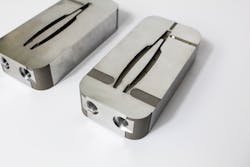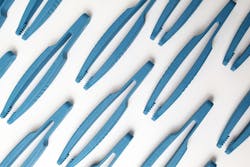3D treatment delivers results in surgical-tool test
Problem: Companies trying to test a new resin needed quick-turnaround prototype tooling that could handle its unique characteristics and create production-quality parts.
Solution: Compounder Foster used Mantle’s TrueShape 3D printing process and equipment to produce tooling for first-run samples.
By Karen Hanna
Stainless-steel forceps, once ubiquitous surgical tools, could be heading in the same direction as the bags doctors once carried, as parts customers in the health-care industry realize plastics’ potential to replace metal.
For Foster, a Putnam, Conn., compounder and distributor of resin from Arkema, the challenge was proving that a new PA 11 resin, called Rilsan FKZM 65 O TD MED, was up to the task and could be processed efficiently. To test the resin, the company undertook the challenge of designing a process to produce plastic forceps that could handle health-care industry needs.
Larry Johnson, president of distribution for Foster, believes using plastic to make forceps offers advantages that are worth exploring. Reductions in cost and weight are among the potential benefits.
“You can also probably do a lot of different things with overmolding on it and things like that ... injection molding an elastomer around it, so it feels better, so you have better ergonomics,” he said. “So, there's a lot of different design things you can do with the material that maybe you would make a little more difficult with metal.”
In addition to its other benefits, the bio-based Rilsan FKZM 65 O TD MED is advantageous in that it is fully recyclable, according to Arkema. Formed from castor beans, the resin is rooted in the poorest soils of India, where farmers are benefiting from a cash crop that thrives in the monsoon seasons; the beans need less than a year to grow, compared to the million or so years that pass in the development of fossil fuels.
With glass making up 65 percent of the weight of the com“Based on what we know about highly glass-filled nylons like this, we knew it would be highly abrasive and would most likely give us some challenges if we were to prototype with a traditional quick-turnaround aluminum tool,” Westminster manufacturing engineer Eddie Graff said.
Seth Hale, design and molding engineer for Westminster, agreed that traditional mold making approaches just wouldn’t work.
“When an aluminum tool is used with an abrasive glass-filled material like this, there’s a risk of rounding the edges of the tunnel gate, which can leave a messy gate vestige or extra plastic in the gate area,” he said.
While aluminum is often used in tooling for prototyping, it’s not good enough to meet the rigorous requirements of customers in the medical market.
Enter 3D printing specialist Mantle.
The company’s TrueShape system combines printing, shaping and sintering to form objects from metal — including production-mold-quality steel — at a fraction of the time and cost of conventional manufacturing. With it, manufacturers can create tooling geometries that are not possible using conventional approaches.
“We regularly hear from manufacturers that the best way to test materials and designs is to use the production material and the production manufacturing process, even when prototyping; however, the challenge has been that such robust testing requires making production-quality steel tools,” said Paul DiLaura, chief commercial officer for Mantle. “Since Mantle allows manufacturers to create these steel tools more quickly than ever before, they can get production-quality parts in the hands of their engineers much earlier in the product development process, shaving weeks and months from product launches.”
With Mantle’s technologies, Westminster had tooling — made from Mantle's H13 Flowable Metal Paste material — in just three weeks.
“That’s three weeks to get quality medical parts from design to a prototype tool,” Graff said. “It’s incredible.”
Printing the cavities allowed Westminster to slash its traditional machining operations in half.
The tooling sports a specially printed subgate and conformal cooling lines that more effectively control cavity temperature — a key to properly handling Rilsan FKZM 65 O TD MED. The partners printed the cavities of both halves of the mold simultaneously, according to Westminster.
“In a traditional production tool, we would have constructed the cavity as two separate pieces welded together to achieve conformal cooling,” Graff said. “But with Mantle’s printing abilities, we were able to print the channels into the final block, right off the printer.”
The approach saved both time and money, he said.
The result was quick-turnaround tooling that produced prototypes that provide enough information to know how the forceps would perform in real-world medical settings.
In March at the PTXPO show in Rosemont, Ill., Westminster announced the verdict: Rilsan FKZM 65 O TD MED can be used to make surgical tools.
“There's two objectives,” Johnson explained. “No. 1: Can you process this material? The answer is yes, and the part looked nice. And No. 2: Is there functionality there? The answer is yes.”
Surgical Dynamics, a Consett, England, maker of medical tools, already has had experience with the resin.
“We have found in this new polymer an ideal material for our surgical tools due to its excellent mechanical characteristics and bio compatibility,” Mark Jessup, the company’s managing director, said in an endorsement of the material for an Arkema resin brochure.
Compared to another surgical-tool resin, Rilsan FKZM 65 O TD MED requires lower molding temperatures, injection pressures and cycle times. It also can withstand autoclaving, Jessup said.
According to a presentation released by Westminster, the forceps produced by the partners met a tolerance of within 0.0015 inch. They had no visible flash, sink marks, discoloration, or surface-finish abnormalities.
“I saw parts, they looked very good. ... From the standpoint of executing the tweezer and having it come back to where it was before you did that, they were very functional,” Johnson said.
Karen Hanna, senior staff reporter
Contact:
Arkema Inc., King of Prussia, Pa., 610-205-7000, www.arkema.com
Foster Corp., Putnam, Conn., 860-928-4102, www.fostercomp.com
Mantle Inc., San Francisco, 415-655-3555, www.mantle3d.com
Westminster Tool, Plainfield, Conn., 860-564-6966, www.westminstertool.com
About the Author
Karen Hanna
Senior Staff Reporter
Senior Staff Reporter Karen Hanna covers injection molding, molds and tooling, processors, workforce and other topics, and writes features including In Other Words and Problem Solved for Plastics Machinery & Manufacturing, Plastics Recycling and The Journal of Blow Molding. She has more than 15 years of experience in daily and magazine journalism.


